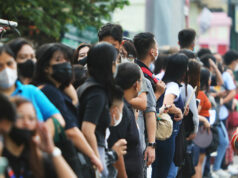BSP pumps more cash into economy with cut in banks’ reserve requirements
THE Bangko Sentral ng Pilipinas (BSP) will slash the reserve requirement ratio (RRR) of universal and commercial banks by 200 basis points (bps) to release additional liquidity into the market amid the coronavirus disease 2019 (COVID-19) outbreak.
The Monetary Board (MB) also authorized BSP Governor Benjamin E. Diokno to cut the RRR of BSP-supervised financial institutions up to a maximum of 400 bps for 2020 in a special meeting on Monday, the central bank said in a statement released Tuesday.
The BSP said the RRR cut for big banks to 12% will take effect on March 30 and added it will issue guidelines on the adjustment.
“The RR cut is intended to calm the markets and to encourage banks to continue lending to both retail and corporate sectors. This will ensure sufficient domestic liquidity in support of economic activity amidst this global pandemic due to the coronavirus disease,” the central bank said.
Mr. Diokno said in a text message that the 200-bps reduction will release about P180 billion to P200 billion into the financial system.
The central bank said potential cuts to the reserve requirements for other banks and non-bank financial institutions will also be explored.
“To properly calibrate reduction in the RR, the MB likewise authorized the BSP Governor to determine the timing, extent, and coverage of the reduction in the RR, taking into consideration the impact of COVID-19 on domestic liquidity,” the BSP said. “The authority given to the Governor to adjust the RR allows the BSP flexibility to promptly address any possible liquidity strain in the industry.”
The reserve ratios of thrift and rural banks stand at four percent and three percent, respectively, while the RRR of non-banks with quasi-banking functions is at 14%.
In 2019, the BSP slashed RRR of big lenders by 400 bps. Mr. Diokno has said he wants to reduce big banks’ RRR to single digit level by the end of his term.
UnionBank of the Philippines, Inc. Chief Economist Ruben Carlo O. Asuncion said the RRR reduction will ensure credit and liquidity is available.
“Cash must continue to flow especially during these extraordinary times. We are, in a way, in a good place because we can still sort of ‘liquify’ the markets and keep the money flowing in the economy,” he said in an e-mail.
Mr. Asuncion added the BSP should cut other lenders’ reserve ratios “as soon as possible.”
“Do what is possible so that the economy can sidestep a potential recession in the next quarters,” he said.
For his part, Michael L. Ricafort, chief economist at Rizal Commercial Banking Corp., said the additional liquidity from this fresh cut will support financial markets.
“Some of the peso funds may also be invested into the local financial markets, thereby could also somewhat help stabilize and support the local financial markets as well such as money markets, bonds, and other fixed income investments,” Mr. Ricafort said in an e-mail.
At this point, however, monetary policy is only one side of the equation in laying the groundwork for economic recovery, ING Bank N.V.-Manila Senior Economist Nicholas Antonio T. Mapa said in an e-mail.
“With central banks here and abroad [firing out stimulus], we wonder when the fiscal side will come in and join the rescue,” Mr. Mapa said in an e-mail.
The BSP last week cut rates by 50 bps to help boost the economy amid an expected slowdown due to the outbreak. This brought the overnight reverse repurchase rate to 3.25%, while overnight lending and deposit rates were trimmed to 3.75 to 2.75%, respectively.
On Monday, the central bank announced it will buy P300 billion in securities from the Bureau of the Treasury to help the government fund initiatives to help the economy weather COVID-19’s effects.
On the fiscal side, economic managers earlier announced a P27.1-billion stimulus package to help sectors most affected by the virus outbreak. — L.W.T. Noble



